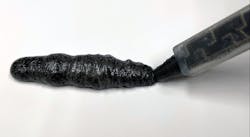Flexible or rigid, when it comes to repairing foams, it’s all about the flow
What you'll learn:
- Application techniques
- Differences in using pneumatic and manual applicators
- Why corrosion protection is applied only after foam installation
Foams, whether flexible or rigid, are commonly used in the automotive aftermarket industry to reduce noise vibration and harshness, to keep water and road chemicals out, and prevent wear and tear on certain components. Given the variety of uses, selecting the type of foam to repair a vehicle also determines which application method should be used for a successful repair.
Applying flexible and rigid foams
Flexible foams are typically applied in the portions of the inner cavities above the door strikers and are used for controlling panel flexing, air movement and sound absorption. Alternatively, rigid foams are typically found in the lower portions below the door strikers and are used for absorbing crash energy in some models, most noticeable in many Dodge, Jeep and Chrysler vehicles, and for controlling air flow and absorbing noise.
When applying a flexible foam into an area such as a door shell or roof skin, it is best practice to slowly dispense the material. This will allow it to foam as it comes out of the static mixing nozzle and prevent leaks and material expansion. Often, however, rigid foams cannot be applied directly into the area needed for repair; the material is instead applied through an access hole located near the area where the original foam was removed. In most cases, the foam needs to flow into an area – such as a rocker panel or b-pillar – before expanding, because most applications don’t allow a direct access point and can span many feet of the repair or replacement panel.
Factory-installed flexible foams can be removed and reinstalled, particularly when repairing hard-to-reach areas such as sail panels, dog legs or pillars. In many of these areas, the foams are attached to a plastic or metal dam to help fill the open space and still provide the performance required. When reattaching original and undamaged foam previously removed for repairs such as panel replacement, the 3M NVH 4274 Dampening Material can be used to coat existing foams before reinstallation of outer body panels, or to fill thin gaps where the foam cannot be used. In the case where the original foam is damaged, follow the Original-Equipment-Manufacturer’s (OEM) recommendations for replacement.
Manual vs. Pneumatic applicators
When applying foams, whether flexible or rigid, it is recommended to use a manual applicator instead of a pneumatic one. The latter can result in loss of control over the dispense rate of the material and the location it is being dispensed to. This is particularly true when dealing with foams in a liquid state, given their low viscosity levels. However, to ensure proper mixing and sufficient control of the dispense rate when using a pneumatic applicator, turn on the air pressure, and test the dispensing of the material on a disposable mixing sheet before applying the foam into areas of the vehicle.
Corrosion protection
For corrosion protection, apply both flexible and rigid foams before cavity wax in order to prevent the material from bonding to the surface. This will allow the foam to fully expand and cure and ensure proper corrosion protection.
About the Author

Ryan Marrinan
Ryan Marrinan is a senior application engineer for 3M’s Automotive Aftermarket Division, supporting global fillers, adhesives, coatings, and sealers. Prior to moving into a full-time role with 3M, Ryan served as a collision repair technician for 20 years and during that time, as an independent consultant for 3M’s Automotive Aftermarket Division for 15 years. During his time as a technician, Ryan specialized in heavy collision and structural repairs, as well as glue pulling and paintless dent repair. Ryan is an I-CAR-certified technician with vast experience and understanding of OEM repair requirements and procedures. As a 3M application engineer, Ryan has the understanding and knowledge to replicate and develop OEM coatings and seam sealers to meet the standards and needs of the collision industry.
